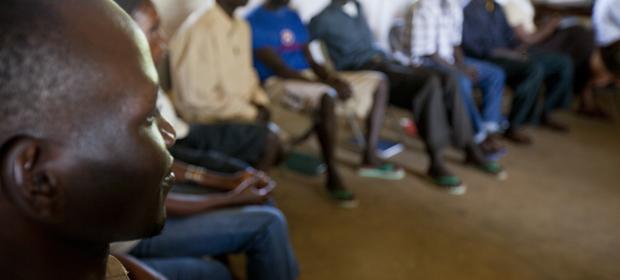Where We Work
See our interactive map


Rwanda is one of the fastest growing sub-Saharan countries, outpacing many of its neighbors in guaranteeing its people a basic education, necessary health care, and safe water. In recent years, these investments have paid dividends in the form of dramatic improvements on important health indicators. More Rwandan women are delivering in a health facility with the assistance of a trained health provider, and more Rwandan children are living through infancy and early childhood [1].
With more Rwandans getting the information and health services they need to care for and protect their children, they are also seeking to have smaller families. In 2005, Rwandans reported wanting, on average, 4.6 children although they had an average of 6.1 children [2]. The most recent data, from the 2007/2008 Demographic and Health survey, indicate a dramatic drop both in the number of children Rwandans want and the number of children they are having. That data suggests that, on average, Rwandans want 3.7 children and are having 5.5 children [3]. Even as Rwandans desire smaller families and are increasingly supportive of and using modern family planning methods, a third of married, Rwandan women have an unmet need for family planning services [4]. Unlike in past years, the majority of these women report they need contraceptives to prevent future pregnancies as opposed to spacing their pregnancies [4].
Recognizing that satisfying unmet needs for family planning services can be an important strategy for reducing poverty, the Rwandan government has supported and encouraged the shift towards smaller families by making contraceptives more widely available and affordable and training providers to offer contraceptive options.
The Rwandan government has collaborated with a number of nongovernmental organizations, including IntraHealth International for many years, to develop the Rwandan national reproductive health policy and a national family planning strategy as well as to revise the national population policy. IntraHealth has worked directly with health center managers and health workers to guarantee that health centers have the supplies and trained personnel to offer a full package of contraceptive methods, including long-acting and permanent methods. Through a number of different projects, IntraHealth staff worked with health facilities, including those supported by the Catholic Church, to offer local health workers on-the-job training in reproductive health care and counseling, including family planning services, and to encourage them to provide services that were accessible and sensitive to adolescents’ needs. This work has made contraceptives more acceptable, available, and more widely used. IntraHealth also worked with the Rwandan government on a special initiative to educate and train journalists, local mayors, and other authorities about family planning and reproductive health.
In addition to Rwandan government’s aim to guarantee all women access to the contraceptive option of their choice, the government has taken a unique approach to meet men’s contraceptive needs. Although a number of different options are available for women, men’s contraceptive options are currently limited to condoms, vasectomy, withdrawal, and abstinence. Given the reported desire on the part of many Rwandan women to use contraceptives to prevent rather than space future pregnancies, long-acting or permanent contraceptive methods may be a good fit for some couples.
Recently, IntraHealth released a technical brief, “Successful No-Scalpel Vasectomy Pilot Program in Rwanda,” which describes a train-the-trainer model for promoting vasectomies as an option for meeting men’s and couples’ contraceptive needs. This model is built on partnerships with district leaders, community health workers, and local health centers to educate communities about vasectomy and make these services available. The brief examines the type of men who sought the procedure and found that vasectomy clients were slightly older, had more children than their peers, and were primarily farmers from rural areas with primary education or less. This pilot program’s findings are an important addition to the body of evidence on the need for more widely available vasectomy services as a part of family planning and reproductive health programs in sub-Saharan Africa.
To read the full technical brief, click here.
 |
References
1. Demographic and Health Surveys. Quickstats: Selected Indicators for Rwanda. Accessed March 11, 2011.
2. Rwanda Ministry of Health, National Institute of Statistics, ICF Macro. July 2006. Rwanda: Standard DHS, 2005. Calverton, MD: MOH, NISR, ICF Macro.
3. Rwanda Ministry of Health, National Institute of Statistics, ICF Macro. April 2009. Rwanda Interim Demographic and Health Survey 2007-2008. Calverton, MD: MOH, NISR, ICF Macro.
4. Ayad, M. and R. Hong. 2009. Rwanda further analysis levels and trends of contraceptive prevalence and estimate of unmet need for family planning in Rwanda further analysis of the Rwanda demographic and health surveys, 2000–2007/08. Calverton, MD: ICF Macro.
Pile, J.M., and M.A. Barone. 2009. Demographics of vasectomy—USA and international. The Urologic Clinics of North America 36(3), 295-305.
IntraHealth International’s has worked in Rwanda through the PRIME II Project, the ACQUIRE Project, the Twubakane Decentralization and Health Program, and the Capacity Project, all supported by USAID as well as the Packard Adolescent Reproductive Health Initiative and the Tides Family Planning Integration Project. It continues this work through the USAID-funded HIV/AIDS Clinical Services Program and the Expanding Rwanda’s Commitment to Population, Family Planning, and Reproductive Health project, which is supported by the William and Flora Hewlett Foundation.



